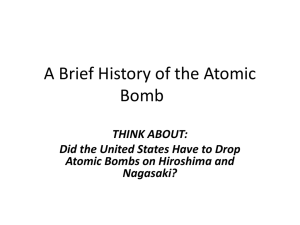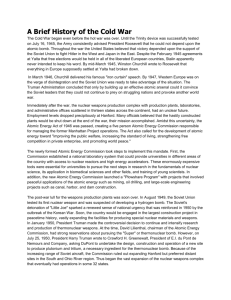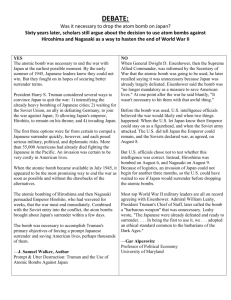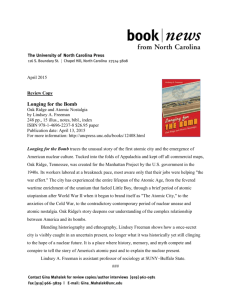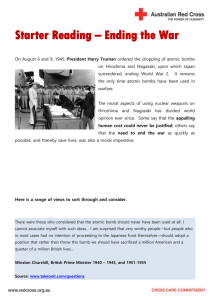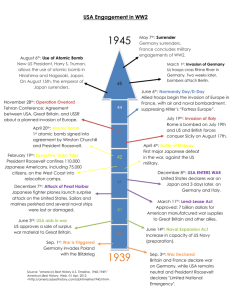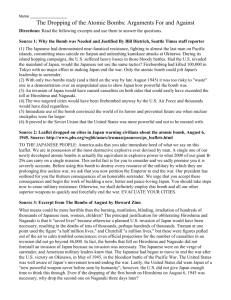The Bombing of Hiroshima and Nagasaki
advertisement
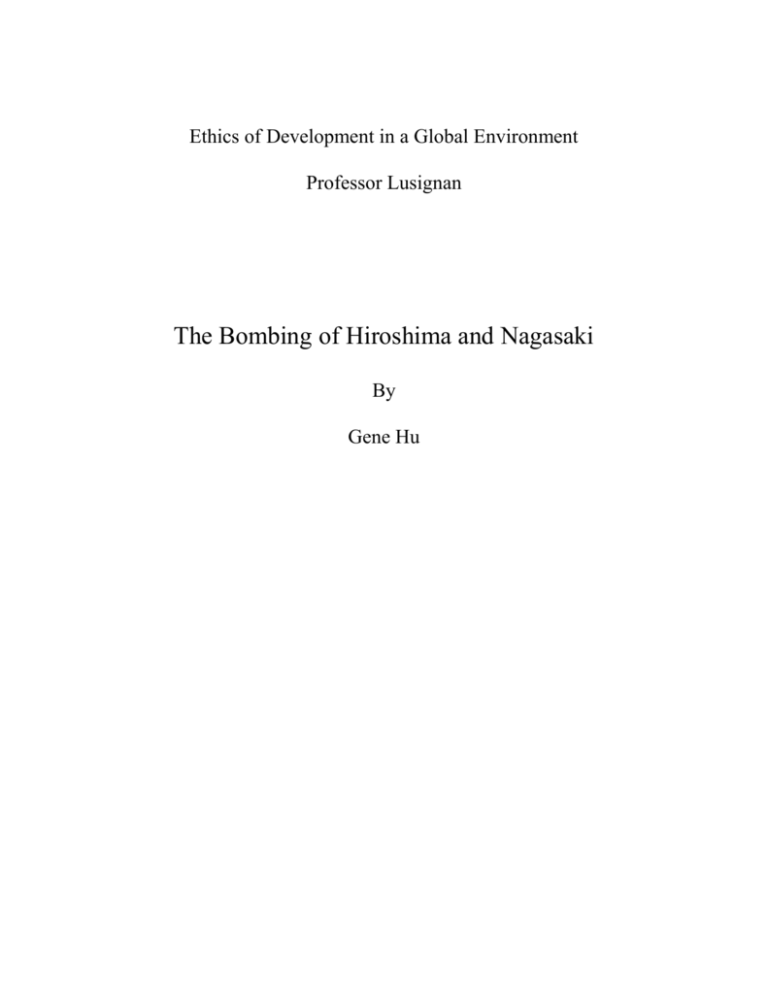
Ethics of Development in a Global Environment Professor Lusignan The Bombing of Hiroshima and Nagasaki By Gene Hu The bombing of two heavily populated cities, which resulted in the deaths of more than 100,000 civilians and an even greater number of casualties, cannot be easily justified regardless of the attack’s outcome. Thus, controversy still surrounds the American use of atomic bombs against the Japanese cities of Hiroshima and Nagasaki, an event that occurred over half a century ago. Many historians argue that the atomic bombing of the two Japanese cities won the war in the Pacific while others argue that at most it only accelerated Japan’s defeat, which to many was viewed as an unavoidable outcome. As a counter argument, many exponents of America’s decision to use atomic weapons against the Japanese populace contend that while it may be true that Japan’s defeat was inevitable, if the U.S. had not used atomic weapons against Japan, the use of ground troops would have been required. This type of assault on the Japanese homeland would have most likely resulted in up to 500,000 military casualties and an appalling level of civilian destruction. Thus, in terms of absolute utilitarianism, the use of atomic bombs against Japanese cities was the correct choice. However, opponents of the use of atomic bombs, many of who were scientists intimately linked to the development of such weapons, argue in retrospect that the use of atomic bombs against Hiroshima and Nagasaki may in fact have been the first act of the Cold War. After much deliberation, a litigious Smithsonian Institute display of the Enola Gay, the military aircraft that dropped the atomic bombs on Hiroshima and Nagasaki, was never revealed to the American population. The exhibit delineated the full story of U.S. officials’ decision to drop the two atomic bombs and the short term and long term effects of the use of atomic weaponry. Englehardt and Linenthal contend that the bombing of Hiroshima and Nagasaki was directed towards peace while their opponents argue that the atomic bombings brought “destruction and fear to the world.” (2) It is certain that America’s initial use of atomic weapons incited an era of fear of destruction. The Cold War was a struggle between two nuclear super powers. Both sides feared one another for their capacity to wipe out entire civilian populations with the use of their advanced nuclear weaponry. Because of this mutual fear for one’s enemy, many historians contend that the heightened level of apprehension actually maintained peace between the two countries and may have in fact prevented the use of nuclear weapons. If one country was in a dominant position over its enemies, it may have been more likely for greater super powers to use nuclear weapons more liberally. These historians also assert that the controlled use of nuclear bombs on Hiroshima and Nagasaki actually resulted in peace. This is because the atomic weapons represented such an immense danger that reprisal or the prolongation of hostilities would be self-destructive. Thus, arguing for the continuance of war after the bombings would have been indefensible. It is clear now that the moral argument against the use of atomic weapons is inconsistent with the practical, utilitarian rationale for using nuclear arms. Albert Einstein, a major contributor to the creation of atomic weapons, best personifies this conflict between moral perspectives and realistic scenarios. Early on in his career, Professor Einstein was a pacifist who admonished the development of nuclear weapons. However, as he aged, Einstein changed his view on the development and use of atomic bombs. Early into World War II, two German physicists, Halm and Strassman, discovered using theoretical physics that it was possible to create atomic weapons. At first, Professor Einstein was dubious about the idea of using nuclear fission to release enormous amounts of energy. However, after studying Halm and Strassman’s work for several months, Einstein confirmed that the creation of atomic weapons was indeed possible. In 1939, Einstein met with two other theoretical physicists, Silzard and Wigner and declared that it was possible for the Germans to create a nuclear weapon. Einstein, who intimately knew the destructive power an atom bomb could unleash on the world, wasted no time in informing U.S. officials of this newly developed potential threat. In fact, Einstein was so distressed by this development that “he was quite willing to sound the alarm even though it was quite possible that it was a false alarm.” (Pais: 217) Einstein wrote a detailed letter about the potential danger of this new atomic weapon and sent it immediately to President Franklin Roosevelt. After reading Einstein’s forewarning, President Roosevelt took immediate action. Roosevelt assembled a small group to “investigate the potential uses of the fission process.” (White and Gribbin, 238) This team eventually developed into what is now known as the famous Manhattan Project. Einstein was not directly involved with the Manhattan Project, the group that actually developed and created the atomic bombs that were unleashed on Japan. However, Einstein’s theoretical physics laid much of the groundwork for the development of the nuclear weapons. Also, Professor Einstein most certainly was the main impetus for President Roosevelt to look into the potential uses and dangers of atomic weapons. President Roosevelt was compelled enough by Einstein’s words that he actually allocated money and appointed task force members with the intention of harnessing the power of the fission process. Einstein took the research of the nuclear weapons so seriously that when President Roosevelt only assembled a small group at first with limited resources, Einstein wrote a second letter to the President beseeching him to increase his staff and funding. Einstein’s stance on the use of nuclear weapons was similar to those historians and philosophers who morally justify the use of weapons of mass destruction using a utilitarianism approach. Professor Einstein endorsed the use of such weapons, despite their destructive capacities, in the hopes of preventing a greater evil. Einstein had faced a serious moral dilemma when Silzard had asked him to give his support to the creation of an atomic weapons programme. In the space of a few years he had transformed his political view from extreme pacifist to advocate of atomic weaponry. But this change had not come without a great deal of soul-searching. If the Allies did not create the atomic bomb, then the Nazis would. Passive resistance would not work in that situation. (Gribbin and White 1994: 238). Einstein believed that an evil that would prevent a greater evil was a sound enough argument for the use of nuclear weapons. This very simple, one dimensional reasoning seems to be an inappropriate way of thinking for the man who is recognized as the greatest genius of modern time. Most would think that a man of Einstein’s mental capacity would have analyzed the situation with much more complexity, depth, and perspective. However, neither Einstein nor other proponents of America’s decision to use nuclear arms against the Japanese have argued any more sophisticated justifications for such use other than the fact that it is morally correct to use one evil in order to avoid a greater evil. Despite the simple reasoning Einstein provided for the use of nuclear arms, we must keep in mind the other factors that guided Einstein’s choice. Professor Einstein’s support for the development of nuclear arms was intimately linked to the fact that at the same time the German’s were drawing close to creating a nuclear weapon of their own. The U.S. feared the possibility of Germany deploying atomic bombs against Allied forces. This is a significant point given the fact that Germany was no longer a player in the war by the time it was decided to send the Enola Gay to Japan. Therefore, one must clearly distinguish between the endorsement of the development of nuclear weapons, and the decision to actually utilize them against Japan. The former was based on an earlier threat that Nazi Germany might very well design and deploy their own atomic bomb. Included in this argument was the fact that there was little doubt Hitler would have ordered the use of such a weapon. It was believed that Hitler would have utilized nuclear weapons to whatever extent was necessary to win the war. By the time the bomb was dropped on Hiroshima, these threats were no longer existent. The decision could no longer be based on potential threat of nuclear weapon development. Instead, the choice was embedded in debates over which strategies and tactics might best end the war with Japan; the last vestige of the Axis powers. Linenthal (1996) notes that in their memoirs and notes penned after the end of World War II, both Truman and Churchill insisted that the use of the atomic bomb prevented huge potential casualties that would have supposedly resulted ipso facto, from an invasion of Japan by more conventional forces. Linenthal states: High projected casualty figures were useful for those who argued…that President Truman was concerned solely about American lives, and that the use of atomic weapons saved many of them. On any scale of suffering these high numbers meant that the potential dead far outweighed the actual dead of Hiroshima and Nagasaki, thus justifying the use of the weapons. (Emphasis added, 54). Linenthal further contends that once high “potential dead” numbers are established— whether it be in Truman’s diaries or from some other creditable source—it is difficult to dispute them. For example, Truman hypothesized that as many as half a million deaths would have resulted from any different approaches to ending the war. This figure became as entrenched, according to Linenthal, as the six million murdered Jews figure. Just as no one is likely to dispute the six million killed, few were ready to dispute the half a million potential dead. That few would find the above figures contentious is a point worth further discussion. The figure of six million Jews exterminated by the Nazis over the course of World War II may or may not be within a degree of acceptable accuracy. It may or may not even be a precise estimate. But, the fact that anywhere near that number were murdered is the significant and deeply tragic fact. The number itself is not as significant as the general range of the figure. The six million figure, once established, in the years since the war, is difficult to contend not because the figure is accurate or not; but because one would appear to be contending the core fact that millions of Jews were murdered by the Nazis; or, the corollary which is that one would appear to be attempting to decrease the size and extent of the atrocities. In short, there seems to be little point in establishing some precise figure when the overall nature and extent of the atrocity is well captured by the generally accepted figure of six million This same sort of reasoning has been applied to the figure of half a million American lives lost had Truman invaded Japan rather than deploy a nuclear weapon. However, the difference between this figure and the six million lives figure is that the extent of the figure is in fact crucial. The decision to annihilate two cities was dependent on the accuracy of the half a million figure (even as an estimate). Had the estimate been substantially lower, the decision would have—one assumes—been far more difficult. At some certain level, it would have presumably swung the other way; in favor of an invasion. Thus, the establishment of the figure is crucial in determining whether Truman’s argument was reasonable or not. Linenthal catalogues a number of invasion casualty figures in his analysis and eventual argument against the accuracy of the half a million American soldiers figure. The following table focusing on the possible invasion labeled “Olympic” summarizes some of his analysis: INVASION CASUALTY ESTIMATE AMERICAN CASULATIES Kyushu (Olympic) 30-50,0000 Kyushu (Olympic) (Based on Okinawa rates) 10,0000 Kyushu (Olympic), 270,000 (Based on Okinawa) REVISED 50,0000 Normandy Invasion 40,000 Total Pacific Theatre 90,000 Losses (Ibid: 55) The table indicates that the estimates of half a million lost were clearly and seriously wide of any even remotely reasonable figure, according to Linenthal. The actual estimates were much closer to a tenth of the touted figure of half a million American deaths. Linenthal notes that even these, much lower figures caused great consternation among Truman and the American military. The difference between the realistic estimates and the publicized estimates of half a million are that the later figure is of such a nature that it appears to justify the use of the Atomic Bomb against Japan; while the more accurate estimates would have made the decision to use the weapon a decision which one might be able to defend, but which was a profoundly tragic one nonetheless. Put differently, the higher figure seems to overwhelm any objections concerning the use of the atomic bomb. It is a return to the argument that a much greater evil ought to be prevented by a short-term, lesser evil. It should be noted that one might argue that this line of reasoning is not particularly sound; that the higher numbers do not justify the use of a mass-killing weapon. This logic assumes that the weapon is what it is; namely, a bomb that in an instant, results in tens of thousands of civilian deaths and the nearcomplete destruction of a city. Such reasoning is valid enough, but pursuit of the intricacies will remain outside the scope of this essay. Boyer (1995) adds to the conclusions Dower reaches about the highly suspect justification of the use of the atomic bomb on Hiroshima by wondering how the atomic bombs fit the image of the war as the “good war.” By the good war, Boyer means a war which all Americans rallied around and had few if any problems justifying. The good war, Boyer argues was “good” in the public and political mind despite the fact that on reflection, there were several actions which were morally suspect: the internment of the Japanese, the fire bombing of Tokyo and the atomic destruction of Hiroshima and Nagasaki. (119). Boyer points out that Hiroshima and Nagasaki had the greatest potential for stirring up objections to American military tactics and even possibly calling into question the so-called “good war.” Boyer notes that Hollywood and other media released material defending the U.S. decision to the U.S. public: Since most Americans very much wanted to believe the fundamental message of all this propaganda—that dropping the bomb was essential, wholly justified, and fully in keeping with the nation’s high war aims—the opinion molding effort proved highly effective. (Ibid, 121). While Boyer’s conclusion that “most” Americans were positively influenced by such propaganda is a matter for debate, the fact was that public opinion at the time seemed to be generally in favor of such analysis of Truman’s decision to drop the bomb. Boyer raises even more crucial issues in his discussion of the profound levels of meaning which one can not ultimately ignore when trying to understand the consequences and impact of the use of nuclear weapons in Japan. Although no military in a war situation is never particularly fair, it is understood that war ought to be fought between military against military; not military against civilian. If broken, this tacit agreement among warring factions would presumably make it difficult for one or both sides to ever claim theirs was a just war. Boyer summarizes this and the role of atomic weapon use in World War II as follows: The atomic bombing was only the culminating act in the breaking down of a never wholly effective ethical barrier— already breached in World War I by Germany’s U-Boat attacks on passenger ships, at Guernica and Nanking in the 1930’s; in the Nazi V-2 raids on London, Antwerp and other Allied cities; and in the Allied Fire Bombings of Hamburg, Dresden, Tokyo and other crowded urban centres. But the technological gift that the physicists presented to President Truman in 1945 rendered the mass extermination of civilians vastly more efficient, radically raising the stakes the postwar debate over the viability of a ‘just war’ doctrine…(Ibid, 123). In other words, the decision to drop the bomb was one which involved pre-knowledge that thousands Japanese civilians would die. Since this was, by tacit agreement, an unacceptable tactic, it would have been difficult, by default, to justify the decision. At the next level of analysis, the decision could be seen as a new general agreement among warring factions: namely, that the use of force against civilians could indeed be justified when that use of force and outcome were, in the balance, far more just and fair than alternative tactics. Kohn (1995) suggests this as a justifiable possibility when he notes that many believed the Japanese seemed “suicidal” in their Pursuit of the war, and there was little choice but “severe and harsh measures” to combat their determination not to capitulate. (168). Wallace (1995) concurs as he points out that the resistance to defeat was a culture-deep sentiment in Japan. This Japanese resistance to defeat applied equally at the close of the war as it did near the beginning of the war in the Pacific, fought against the Americans. Skates (1994) clearly defines the situation for Japan and for the Allies, at the close of the war: Dominating all considerations was the obstacle of unconditional surrender. Clearly, by any rational measure the Japanese were already defeated in May, 1945. The Imperial Navy had been sunk. The sea lanes over which passed the oil and raw materials from the Indies were cut. Allied aircraft could attack the home islands unopposed. The Japanese homeland was only a step away from complete blockade. Yet the Japanese military proceeded with hopeless and suicidal defenses…(234). This was the reality of Japan’s situation at the time in which Truman had to decide what course to take. On the one hand, this description of Japan’s imminent defeat would seem to indicate that the atomic bomb would have been too severe a solution. After all, Japan was teetering on the brink of defeat anyway, without the extreme measure of dropping the bomb. There are other factors though, which might aid in at least partly explaining the excessive force utilized. For example, any thoroug analysis must address the hatred that was felt by Americans against the Japanese. It was this hatred which might have helped in making the decision to use nuclear weapons palatable and perhaps even desirable, as far as the American public and the American military rank and file were concerned. First, the Japanese racial distinction made them relatively ready targets for American hatred. Certain racial traits and characteristics could be easily assigned to the Japanese and used as rationale for the dislike and even hatred of their behaviors and attitudes. Walker (1997) suggests that racial antipathy is foundational to understanding the nature of the American reaction to Japanese atrocities; and at the same time, that the stage for intense racial hatred was set when the Japanese violated American soil with the bombing of Pearl Harbor. (50) The media fanned the repugnance and horror that many (possibly most), Americans felt toward the Japanese as each new atrocity was dramatically presented in the press. Walker lists several which had particularly impact on Americans: 1. The aerial bombing of civilian targets. 2. The “Rape of Nanking of 1937. 3. “The mutilation of Englishmen in Malay 4. The Bataan Death March of 1942. Walker concludes: The graphic evidence of Japanese atrocities and inhumanity towards prisoners and civilians fed an image of an enemy that was cruel, barbarous and deserving of annihilation.”(Ibid). With the invention of the atomic bomb, that annihilation was made possible. It is astounding to think that such annihilation was partly, racially motivated; but if Walker’s analysis is correct, it apparently was. He states that Americans believed the Japanese were different in their “race and culture,” and in the fundamental nature of their humanity.” (Ibid, 51). One thing seems fairly certain about the use of the atomic bomb in World War II: It was a decision that marked a unique moment in history. No matter how crucial Japan’s own decisions were in forcing the hand of Truman (if it was forced at all), and no matter how misguided the American decision was in the first place, the fact remains that the bomb was used. Dower (1995) states: The sixth and ninth days of August 1945 became detached from the ordinary calendar of World War II. Many Japanese still see themselves as having been chosen, almost in a religious sense, to bear witness to the apocalyptic vision of a world-destroying future that must not be allowed to happen. (66). This might be tantamount to positing that Hiroshima and Nagasaki were, in part, demonstrations of the awesome brutality and inhumanity of nuclear weapons; demonstrations which may have, ironically, aided in maintaining the detente between the super powers in the years following the war. There is considerable evidence that the American perspective on the Soviet Union and the diplomacy that occurred between the U.S. and the Soviet Union prior to these powers entering into a full-blown Cold War, was influenced by the advantage the Americans had because they had developed nuclear weapons technology. The development of such technology moreover, was dramatically and conclusively demonstrated when Truman dropped the bomb on Hiroshima, then Nagasaki. There was no doubt in the world’s mind that the technology was real and that whoever controlled it, wielded an incredible power. One is tempted to conclude that while the bombing of Hiroshima possibly ended the war with Japan in ways that may have spared both sides lives, it also conveniently served to inform the world of the Americans’ superior military might. There is no doubt the Americans were concerned about the relative roles of the Soviet Union and the United States in the postwar world. Noble (1996) in a review of Alperovitch’s work, states: "Uppermost in the minds of Americans in 1945 was not just ending the war but doing so in a way which could be advantageous for negotiating with the Soviet Union about postwar political arrangements in its sphere of influence in Europe and East Asia.”(91). One would have thought that the American advantage achieved through the deployment of nuclear weapons would have been rather substantial, if not decisive. However, it was clearly not as the outcome of the negotiations with the Soviet Union and the Cold War itself bore witness to. Noble agrees with Alperovitch that: “…the use of the atomic bomb achieved no immediate military purpose which could not have been achieved otherwise, nor, in hindsight, any longer term political goals.”(93). This bold statement of course, begs several questions; not the least of which is: Why then the use of the atomic bomb in the first place? And, was the failure to block Soviet expansionism and to prevent the Cold War a matter of failed/ botched diplomacy despite obvious advantages? This is precisely where the work of Alperovitch (1995) is important. His treatise on the matter is carefully wrought and concentrates to the last detail, on negotiations, and diplomacy. WORKS CITED Alperovitch, G. The Decision to Use the Atom Bomb New York: Alfred Knopf. 1995 Boyer, P. “Whose history is it anyway? ,” in, Engelhardt, T. and Linenthal, E. (editors) History Wars. New York: Metropolitan Books. 1996. Dower, J. “Three narratives of our Humanity.” ,” in, Engelhardt, T. and Linenthal, E. (editors) History Wars. New York: Metropolitan Books. 1996. Engelhardt, T. and Linenthal, E. “History under siege,” in, Engelhardt, T. and Linenthal, E. (editors) History Wars. New York: Metropolitan Books. 1996. Kohn, R. “History Risks” in, Engelhardt, T. and Linenthal, E. (editors) History Wars. New York: Metropolitan Books. 1996. Linenthal, E. “Anatomy of a controversy.” ,” in, Engelhardt, T. and Linenthal, E. (editors) History Wars. New York: Metropolitan Books. 1996. Noble, C. “Atomic Diplomacy: Hiroshima and Potsdam: The Use of the Atomic Bomb and the American Confrontation with Soviet Power.” Pacific Affairs Spring 1996. 69 9194. Pais, A. Einstein Lived Here New York: Oxford University Press. 1994 Skates, J. The Invasion of Japan Chapel Hill: University of South Carolina Press. 1994. Walker, J. S. Prompt and Utter Destruction Chapel Hill: University of South Carolina Press. `1997. Wallace, M. “Culture war, history front,” in, Engelhardt, T. and Linenthal, E. (editors) History Wars. New York: Metropolitan Books. 1996. White, M. and Gribbin, J. Einstein New York: Dutton Books. 1994.
